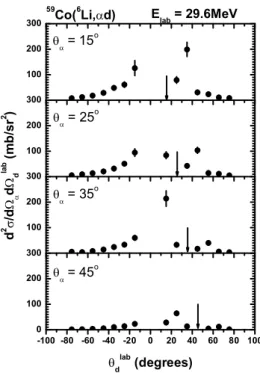888 Brazilian Journal of Physics, vol. 35, no. 3B, September, 2005
Direct Measurement of the Breakup Process
F. A. Souza, R. Liguori Neto, M. M. de Moura, M. G. Munhoz, A. A. P. Suaide, E. M. Szanto, J. Takahashi, A. Szanto de Toledo, and N. Carlin Instituto de F´ısica - Universidade de S˜ao Paulo, Departamento de F´ısica Nuclear,
Laborat´orio Pelletron, Caixa Postal 66318, 05315-970, S ˜ao Paulo - SP, Brazil
Received on 15 November, 2004
In order to better understand the breakup contribution to fusion, we perfomed light particle coincidence measurements for the systems6,7Li+12C,59Co at energies near and above the barrier. A three body kinematics
analysis is performed with the objective of separating the contributions of different reaction mechanisms. For small angular differences between the light particles, the sequential and direct breakup seem to dominate. On the other hand, for large detector separations, a sequential decay following transfer is likely to dominate.
The recent availability of radioactive nuclei beams moti-vated the investigation of fusion reactions involving weakly bound nuclei. The cross section enhancement generally ob-served at sub-barrier energies is understood in terms of dyna-mical processes arising from couplings to collective inelastic excitations of the target and/or projectile [1]. However, in the case of reactions where at least one of the colliding nuclei has a sufficient low binding energy so that breakup becomes an important process, conflicting experimental and theoretical results are reported in recent papers [2–10].
The6,7Li +12C,59Co fusion reactions are used to investigate
the effect of breakup on the fusion cross section [11]. These measurements help to establish the influence of the projec-tile breakup on the fusion process at near-barrier energies and contribute to the determination of how the mass of the target affects the process, as well as the influence of the incomplete fusion yield.
It is important to have clear the reference used when an enhancement and/or a suppression is defined[5–7]. A final tu-ning for the coupling of the breakup channel, as well as the correct description of the reaction dynamics, requires the ex-plicit measurement of precise elastic scattering data as well as yields leading to breakup itself [12–14].
FIG. 1: (a) Bidimensional plot EαxEd. (b) Bidimensional plot EαdxEα, both at Elab=26MeV for the6Li +12C system. The
li-nes represents the loci for events leaving12C in the ground state and the first excited state.
The identification of the breakup products has been achie-ved measuring the three body final state correlations. Coin-cidence data displayed in Fig. 1a show the identification of
FIG. 2: Angular correlations for the system 6Li+59Co at Elab=
29.6MeV as a function of the d angle (θd) for fixedαangles (θα)
indicated by the arrows.
F. A. Souza et. al. 889
FIG. 3: Relative energy betweenαand d for the6Li breakup on the 12C target as a function ofθdfor a fixedθ
α= -25o. The vertical lines represent the kinematical detection limits forα-d decay for the first excited state of6Li (E* = 2.186MeV).
target. The region between the dashed vertical lines repre-sent the angular interval in which the three body kinematics predict a constant relative energy. The fact that this experi-mental trajectory is not constant out of this region indicates the presence of other processes. The fact that the yield for coincidences is not negligible out of this region (see Figs. 2) indicates that the other processes producing, as in this case
α−d coincidences, are relevant and must be identified. Fig. 4 shows theαenergy as a function of the d emission angle. We notice that theαenergy is constant on the angular range which does not correspond to the breakup contribution. This constant energy suggests the presence of a binary intermediate process6,7Li+59Co
→α+61Ni∗→α+d+59Co. From the averageαenergy, we determined the excitation energy of the intermediate nucleus61Ni, as being 25MeV. Similar data were taken for6,7Li+115In. This procedure in unfolding the several
light particle emission processes has not been exploited so far in the literature.
FIG.4: αenergy as a function ofθd forθα= 15o. The excitation energy for the intermediate nucleus61Ni was determined from the averageαenergy indicated by the dotted line.
Acknowledgments
This work was supported by Fundac¸˜ao de Amparo `a Pes-quisa do Estado de S˜ao Paulo (FAPESP)-Brasil.
[1] M. Dasgupta et al., Ann. Rev. Nucl. Part. Sci. 48, 401 (1998) and references therein.
[2] N. Takigawa et al., Phys. Rev. C 47, R2470 (1993).
[3] K. Hagino et al., Phys. Rev. C 61, 037602 (2000) and references therein.
[4] A. Diaz-Torres and I.J. Thompson, Phys. Rev. C 65, 024606 (2002).
[5] J.Takahashi et al., Phys. Rev. Lett. 78, 30 (1997).
[6] A. Szanto de Toledo et al., Nucl. Phys. A 679, 175 (2000). [7] R.Cabezas et al., Phys. Rev. C 60, 067602 (1999).
[8] M .Dasgupta et al., Phys. Rev. Lett 82, 1395 (1999). [9] M .Dasgupta et al., Phys. Rev. C 66, 041602R (2002). [10] V.Tripathi et al., Phys. Rev. Lett. 88, 172701-1 (2001). [11] C. Beck et al., Phys. Rev. C 67, 54602 (2003). [12] K. Rusek et al., Phys. Rev. C 67, 41604 (2003). [13] J.F. Liang et al., Phys. Rev. C 67, 44603 (2003).

